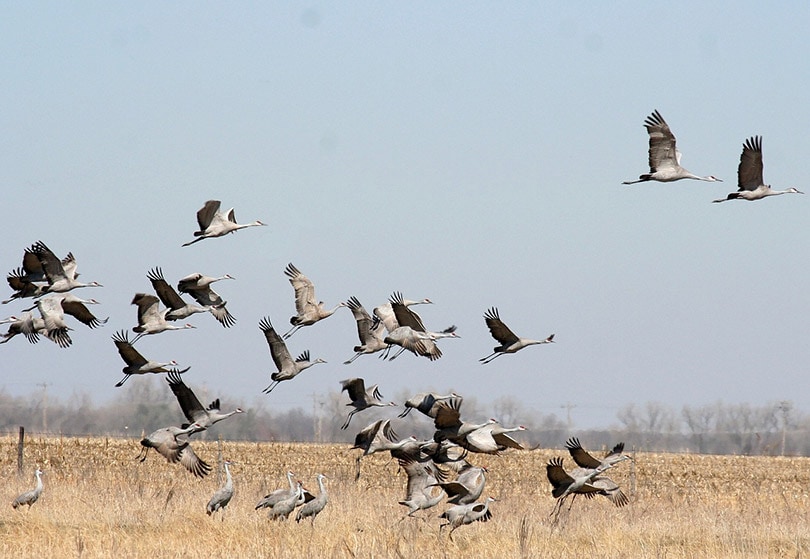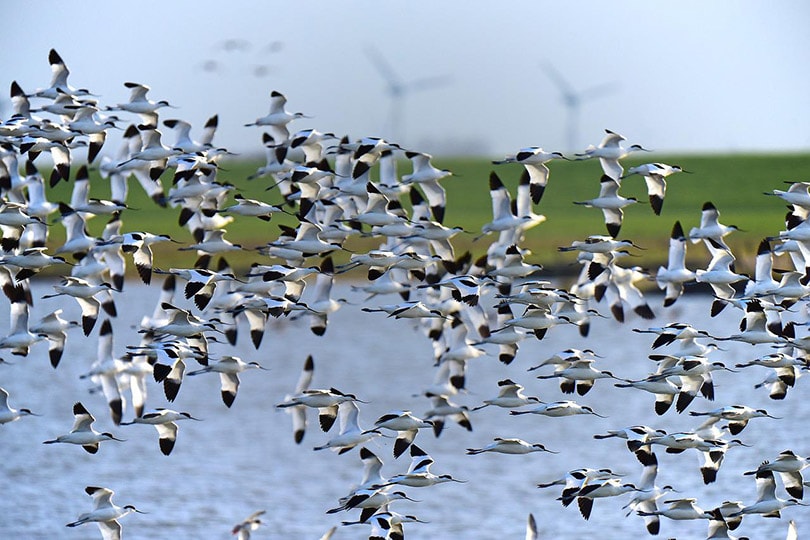Do All Birds Migrate? What The Science Tells Us
Last Updated on

If you live in an area with four seasons, you probably notice migrating birds more than someone who lives in a warmer climate. The outdoors gets pretty quiet starting in late summer since the birds you’ve seen flying around and singing up a storm are gone. Their absence is noticeable, too. That may leave you wondering, do all birds migrate?
The short answer is no. Some of our avian friends stay put year-round and do not migrate.
However, there’s more to the story. Different species fly on various paths with varying distances. Let’s do a deep dive to learn more about this migratory behavior.

Defining Migration
Migrating is defined as “moving from one country, place, or locality to another.” It implies traveling some distance from one’s current location or home base. Several organisms take on this seasonal challenge, including whales, fish, and butterflies. About half of the total North American avian species migrate. Seasonality and predictable movement are two key factors.
You might wonder why birds would do something so strenuous and demanding? They could save a lot of energy by not leaving their stomping grounds. Migrating also poses many risks between aircraft, storms, and predators. Interestingly enough, genetics may hold the answer. A study published in the journal Nature provides compelling evidence that some birds may have a migratory gene. Of course, evolution could also be responsible.

Migration History
Migration isn’t a new behavior. Research has suggested that it has been a part of avian evolution for thousands of years. We know that climate has played a role. However, new findings show that birds took to the air even during the last age and not just between the events. The scientists concluded that birds began migrating for reasons that go beyond the cycles of ice ages.
Migration Triggers
Seasonality
Seasonality helps explain the timing of migration. However, it comes down to other factors affecting a species’ survival, namely, food availability. Scientists know that birds don’t migrate at the same time. For example, many waterfowl species arrive early at their breeding grounds. Others, such as warblers, arrive fashionably late even when spring is well underway.

Food Availability
The difference often depends on the food a particular species eats. Insects are the primary food source for warblers. It wouldn’t make evolutionary sense for them to show up when prey isn’t widely available, especially after their long journey north. The same principle applies when various species are heading south. For example, hummingbirds couldn’t survive colder temperatures without plentiful nectar available.
Therefore, we can conclude that the type and availability of food partially determine an animal’s migratory behavior.
Temperature
Temperature also affects migration. It takes a lot of energy to stay warm. The lack of food makes it even riskier for some species. Bear in mind that some birds are well-adapted to their specific niches. Wading birds, like herons, can navigate shallow waters easily with their long legs.
Likewise, woodpeckers can get an ecological edge simply because they are cavity nesters for fending off the cold winter days. Omnivores have an advantage since they can turn to different food sources.

Adaptation
Flexibility may help some birds make the transition to their wintering grounds and food sources. Research suggests that it’s a vital characteristic of migrating birds. Long-distance travel puts enormous energy demands on these species. Adapting allows these animals to survive even if their physical attributes don’t change for the new foods they consume.
Migration Patterns
We know that climate, seasonality, and food availability influence migration. However, birds possess another incredible thing that isn’t that well understood—navigation. How do birds know how to get from point A to point B? That’s where the concept of flyways comes into play. You can think of flyways as an avian highway system. There are four primary flyways in North America that birds use, including:
- Pacific Flyway
- Central Flyway
- Mississippi Flyway
- Atlantic Flyway
These specific flight paths provide the optimal travel route. Remember that birds have to navigate around obstacles, such as oceans and lakes. These obstacles could make it challenging, if not impossible, to meet the energy demands they would require. An excellent example of one in action occurs at Hawk Ridge near Duluth, Minnesota.
The hurdle these migrating birds face is the bitter coldness of Lake Superior. Hawk Ridge sits at a narrowing of the waterway, providing a more accessible route for raptors. Birdwatchers have counted an average of 76,000 raptors passing through the area, typically around the first few weeks of September.
Rare species, such as the Gyrfalcon and Mississippi Kite, have given many birdwatchers here a once-in-a-lifetime experience. Not surprisingly, spring and fall migrations are significant events that draw thousands to the area, making it a popular wildlife-viewing destination.
Migration Types
This distance that birds will travel varies as well. They could travel short, medium, or long distances during migration. Ornithologists have identified three range points and a midway point related to seasonal movement patterns. They include:
- Year-round resident
- Staging areas
- Breeding grounds
- Overwintering grounds
Here is where we can delve into the particulars of migration. A year-round resident may not follow a seasonal travel pattern. Instead, they may only fly short distances to find food. For example, Northern Flickers often move out of northern parts of Minnesota to find food farther south. Mountain-dwelling species follow a similar pattern, going down to lower elevations.
Other birds, such as the Blue Jay, extend their ranges farther north during the summer. They don’t live in these places year-round, limiting their use of these patterns to times when they can survive. Birds that travel long distances often gather at various areas along their routes. You may only get a short glimpse of these species on their way to the breeding grounds. Warblers and waterfowl are two classic examples.
Breeding grounds are where you can see birds at their best. They have their brightest and most vibrant plumage and are highly active, using vocalizations and non-vocal communication. As a result, birdwatchers find identification easiest in these places, even with verdant vegetation. On the other hand, overwintering grounds often support large groups of birds.

Conclusion
Migration gives birds an evolutionary advantage if they depend on seasonal food sources. It allows them to survive regardless of the conditions at home. It’s no wonder that other animals follow a similar strategy. However, migration isn’t a be-all-end-all solution for all birds. Species such as the Wild Turkey, Black-Capped Chickadee, and Northern Cardinal do just fine staying close to home.
Featured Image Credit: ladymacbeth, Pixabay
About the Author Chris Dinesen Rogers
Chris has been writing since 2009 on a variety of topics. Her motto with all of her writing is “science-based writing nurtured by education and critical thinking.” Chris specializes in science topics and has a special love for health and environmental topics, and animals of all shapes and sizes.
Related Articles:
What Is the Best Binocular Magnification for Hunting? Optical Features Explained
Can You Use Binoculars to Look At Stars? How to Choose the Right Pair
10 Types of Hummingbirds in Arkansas (With Pictures)
8 Types of Hummingbirds in Nebraska (With Pictures)
5 Types of Hummingbirds in Idaho (With Pictures)
3 Types of Hummingbirds in Mississippi (With Pictures)
8 Types of Hummingbirds in Kansas (With Pictures)
5 Types of Hummingbirds in West Virginia (With Pictures)
